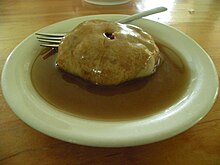
| Cuisine of Quebec |
|---|
 |
| Part of a series on |
| Canadian cuisine |
|---|
 |
|
|
Acadian cuisine (French: Cuisine acadienne) comprises the traditional dishes of the Acadian people.[1][2][3] It is primarily seen in the present-day cultural region of Acadia.Note 1 Acadian cuisine has been influenced by the Deportation of the Acadians, proximity to the ocean, the Canadian winter, bad soil fertility, the cuisine of Quebec, American cuisine, and English cuisine, among other factors.
Acadian cuisine is not very well known in Canada or internationally. It has much in common with Québécois cuisine because of its geographical proximity. The two often feature the same dishes, but the cuisine of Acadia puts more emphasis on seafood. Acadian cuisine has notably served as the base for Cajun cuisine because the Cajun are descendants of Acadians who were deported to Louisiana.Note 2[4] It is also believed that Acadians are responsible for normalizing potato consumption in France—a vegetable the French once considered poisonous.
In the 17th century, French colonists who settled on lands they named Acadia adapted their 16th-century French cuisine to incorporate the crops, seafood and animals that flourished in the region. Their descendants became the Acadian people and their ingenuity created Acadian cuisine.
After the English conquered Acadia during the 18th century, they decided to deport the Acadians and take their settlements, which were often built on the most fertile earth in the colony. Most Acadians did not manage to escape the deportation. But, of those who did, most fled to the east and north of New BrunswickNote 3. As such, Acadian cuisine in the 18th century was refocused around what could be grown, hunted and fished in the less fertile lands of the East Coast of New Brunswick and the Upper St. John River Valley.[5]
Acadian cuisine often features fish and seafood, especially cod and Atlantic herring, but also mackerel, berlicoco, lobster, crab, salmon, mussels, trout, clams, flounder, smelt and scallops. Most fish is consumed fresh, but some are boucané (smoked), marinated or salted.
The most commonly used meat is pork, followed by chicken and beef. As with the rest of North America, turkey is commonly consumed during the Holidays. Game like deer, hare, ruffed grouse and moose is consumed regularly in some regions. Game will replace livestock meat if present and can be given as a gift. In some regions, for example Caraquet and the Îles-de-la-Madeleine, more unusual game is or was caught like seal, bear and seagull.
The vegetables of Acadian cuisine are the potato, onion, carrot, turnip, legume, beet, squash and corn. These vegetables were popular because they were easily preserved for the winter in root cellars and jars. The fiddlehead fern was introduced to the Acadians by the indigenous Maliseet, Mi'kmaq and Penobscot peoples in the early 18th Century and remains a popular Acadian dish.
Popular fruits include blueberries, apples, strawberries, raspberries, blackberries, plums, pears and cranberries.
Some ingredients like rice, molasses, dried raisins and brown sugar are part of Acadian cuisine because of historical commerce between Acadia and regions like the Antilles and Brazil. Maple sugar is also a popular sweetener, given the often-close familial ties between Quebec (the world's largest producer of maple sugar) and Acadia.



Some examples of traditional Acadian dishes are: